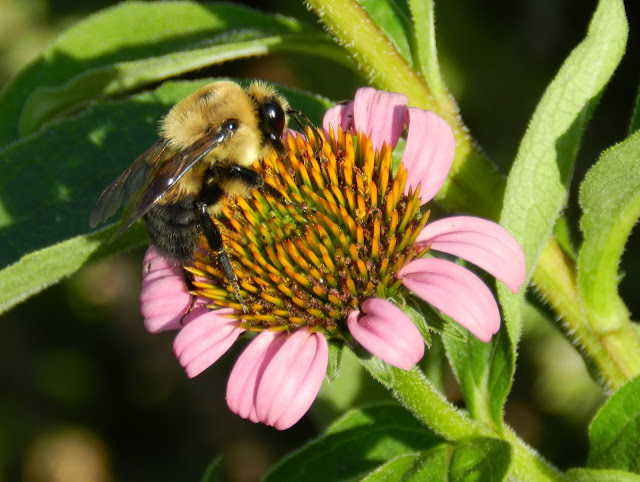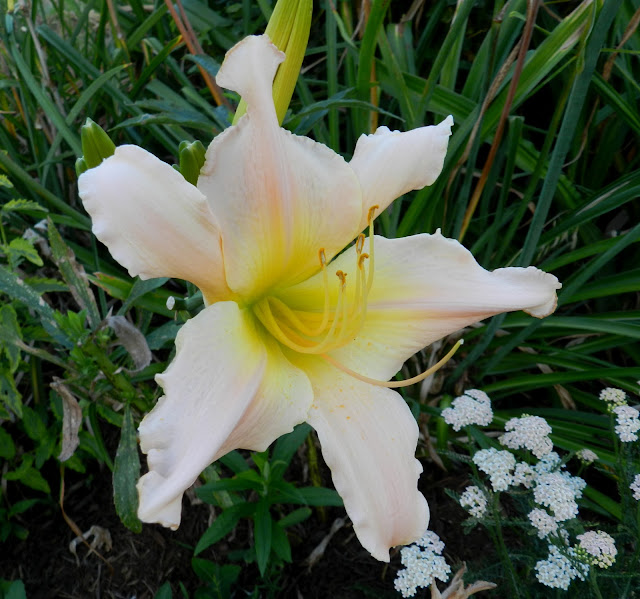I am not going to complain about the weather today . . . I am not going to complain that despite a few showers the past week, we are still in the middle of a severe drought . . . I am not going to complain about how miserably, intolerably hot it has been, with temperatures near 100 degrees (that's 37.7 C for those outside the U.S.) for days on end . . . with no end in sight. And I'm not going to complain that in the midst of this sweat-inducing heat that our central A/C went out, and I'm spending my days in the basement where it's cool, being a couch potato while we wait for a new unit to be installed.
No, I'm not going to complain about all of this, because there's not a darned thing I can do about the weather anyway.
So instead of complaining about the present, let's take a little diversion to something more pleasant and go on a couple of garden tours.
Last month our Master Gardener group held its annual Garden Walk. Out of the usual eight or nine gardens featured, there is usually one that stands out more than the others. This year the garden that really had a wow factor for me was this Japanese garden. Driving down this semi-rural street one would never guess what lay behind the fence.
 |
| Back view of the house |
Since I was working as a guide at the walk the next day, I was able to preview the gardens the evening before. This was nice because there were only three of us visiting this garden when I arrived, and we had a chance to talk in depth with the owner and learn more about how this garden evolved.
 |
| Koi pond--sorry, it was that time of day when shadows prevented really good photos. |
The owner has visited gardens in Japan and Japanese gardens across this country and has an extensive knowledge of the principles of this type of gardening. Besides his own garden, which he began over 45 years ago, he also designed and maintains the garden surrounding Japan House on the university campus.
Authentic touches were everywhere, such as this screen made from real bamboo on a porch entry.
A tea house invites visitors to stop and sit and reflect.
Meandering paths led to all kinds of surprising delights; this large juniper "mushroom" caught everyone's eye, though. If I remember correctly, James said he prunes this only once, maybe twice, a year. Regular readers of this blog may remember how much I love Japanese gardens, so finding this lovely place literally in the middle of cornfields was truly a delight.

Two of the gardens on the walk were on adjoining lots, which made it convenient for visitors to leisurely stroll from one garden to another. This is the back yard of the garden where I was stationed. Sally's home is very contemporary with handcrafted stone and wood pieces, and her garden reflects that same contemporary style. Rather than exuberant plantings of colorful blooms, her garden depends more on sculptural shapes and is full of interesting specimens. Unfortunately, I was too busy trying to answer questions to take many photos! In the top center of the photo you can barely see a lakeside planting that is part of the next door garden. This was a terraced area with beautiful hardscaping filled with colorful plants--again no close-up.
The path shown above made for a natural flow into the neighboring garden and down to the lake. I had to get up close to realize this heron wasn't real!
Even though Sally's garden included some exotic specimens that are way beyond my budget, there still were sources of inspiration. In a simple planting near the front sidewalk, 'Black and Blue' salvia makes an eye-catching contrast to the green leaves of iris.
Container plantings also always provide some new ideas--and what a colorful way to hide the air conditioning unit!
When I volunteered to help at the Garden Walk, I randomly picked a garden to work in. Had I seen the gardens first, I probably would have picked the house next door . . . and this spot as my "station." Fortunately, it was only in the low 80's on this day, but I still saw several people taking advantage of this shady spot for a momentary rest.
Sharon's garden next door featured many more colorful plantings, and the highlight was an elaborate fairy village in a front garden . . . but once again, I was camera-less. I did manage to capture this smiling Buddha, however, although the real reason I took this photo was to remind myself of the sedum in front of him. I've forgotten the name, but this is a plant I've wanted to include in my garden for a long time.
Another planter in the narrow side garden also caught my eye.
A third garden in this very upscale neighborhood also featured some interesting sculptures.
And lots of hardscaping, especially curved brick paths around the different areas of the garden.
Many of the flowerbeds in this garden followed the design principle
of planting in drifts, including these drifts of lilies.
Or drifts of Crotons. I'm not especially fond of crotons, but I thought this was interesting.
The other private gardens on the tour were not as elaborate, but in some ways less intimidating, because they seemed more "do-able" for the gardener on a more limited budget. This shaded koi pond was the focal point of one of these gardens.
A rusty pump and other collectibles find new life as garden accents.
Miniature hostas in concrete troughs were just a small part of Bev's large hosta collection.
Colorful window boxes greeted visitors at the final garden.
No room or budget for a large pond? A small container makes an attractive water feature, too.
Despite all the colorful plantings at this last garden, I think the highlight for many of us was this compost bin built by the gardener's husband. It prompted quite a few cases of garden envy.
If you're not too tired, how about another garden tour? Don't worry--this will be an abbreviated one, because as you'll soon see weather kept me from taking many photos.
Two weeks ago our local garden group also held a garden walk. I always enjoy this one, because the gardens tend to be smaller than those selected for our MG Walk, and I often come away with some practical ideas for my own garden. I usually know many of the gardeners, so it also becomes a chance to visit and talk gardening with some like-minded people. Accompanied by friend Beckie and her four granddaughters, we made the rounds of five local gardens.
A simple planting of Rudbeckia becomes even more attractive with the addition of a garden bench.
A mass planting of gray-headed coneflowers really caught my eye--I have yet to have success growing these from seed. Notice the old cream separator holding petunias and other annuals at the front of this berm.
Only two of the gardens were actually in town; the other three were a short drive into the country. The first of these was on a farm, and it appealed to me because it was much like my own--no one central garden, but rather various garden areas scattered around the property. I liked the simplicity of this arrangement.
But what I most enjoyed here was the gardener's sense of humor. This area was planted with annuals, which, according to the sign, were "rescued" from our local grocery store at the end of spring for $5 a flat.
By the time we reached the next garden, the light sprinkles that had been following us around all afternoon finally turned into a downpour. Such a shame, because this garden was so beautiful--full of all kinds of plants, country-style garden art and accents, and different garden rooms to explore. But those blurs on the photo above were actually raindrops, and I quickly realized I needed to put my camera away in a dry place before I ruined it. Umbrellas were quickly opened--by those that carried them; I opted for getting drenched instead--but you never saw so many smiling gardeners tromping through soggy lawn:)

The final garden was a complete surprise to me; little did Beckie and I know what awaited us after a long walk past this entrance garden to the real garden lying behind the house. The owner of this property is a former student of mine from my first year of teaching, and although I occasionally run into him, I never knew he was a gardener. And what a gardener he is--he has transformed his seven acres into a beautiful private sanctuary, filled with raised berms for perennials, another sloping area planted with a variety of trees, and a pond filled with catfish with its own sandy beach.

The piece de resistance is this large pond, complete with five waterfalls. And did I mention that except for the large fishing pond, Kevin did all the work himself? In fact, he's working on adding one more waterfall here. Once again, you'll notice the raindrops blurring my photo. Sadly, I had to put my camera away, but a little rain didn't stop me from enjoying every moment walking through his garden. This place was truly a jewel hidden in the cornfields.
If you've made it this far, I thank you for hanging in with me for this overly long post. I'll leave you with this image of a huge lotus blossom floating in Kevin's pool. Now just repeat this mantra with me:
Stay calm. Stay cool. Think rain.






























































